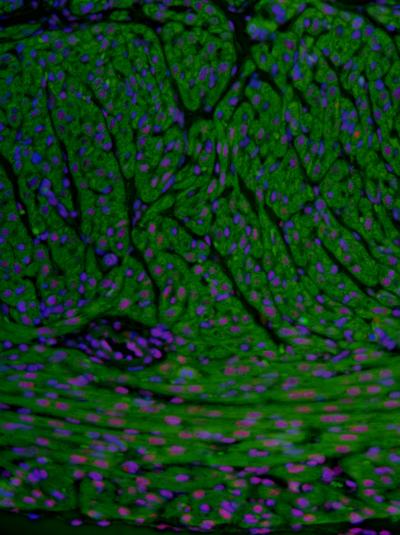Knowledge of the mechanism of action of SRSF3 could open the way to the design of new therapeutic approaches to heart disease

Credit: CNIC
2019 A team of scientists led by Dr Enrique Lara Pezzi at the Centro Nacional de Investigaciones Cardiovasculares (CNIC) has identified the RNA-binding protein SRSF3 as an essential factor for proper heart contraction and survival. In a study published in Circulation Research, the researchers found that loss of cardiac expression of SRSF3 leads to a critical reduction in the expression of genes involved in contraction. Knowledge of the mechanism of action of SRSF3 in the heart could open the way to the design of new therapeutic approaches for the treatment of heart disease.
Cardiovascular disease is the leading cause of death in the world. In 2015 alone, cardiovascular disease killed 17.7 million people, with 6.7 million of these deaths caused by heart attack. Unfortunately, knowledge is limited about the molecular mechanisms that regulate progression of a myocardial infarction, sytmieing the development of new therapeutic approaches. The recent development of massive-scale messenger RNA (mRNA) sequencing technology has permitted the identification of gene expression patterns associated with the development of heart disease. Nevertheless, understanding of posttranscriptional regulation (a type of gene regulation) remains limited, in particular about the roles played by RNA-binding proteins (RBP) in myocardial infarction and the development of heart disease.
RNA-binding proteins perform important tasks in the cell. “In this study, we have investigated the role of the RBP SRSF3 in the heart, which was unknown until now,” explained Dr Lara Pezzi.
Study first author Dr Paula Ortiz Sánchez, together with the rest of the research team, found that during embryonic development SRFS3 is expressed at high levels in cardiomyocytes and regulates their division. “Embryos lacking SRSF3 in these cells die,” said Dr Lara Pezzi. But in the adult heart, “cardiomyocytes barely divide, and SRSF3 expression is much lower, especially after a heart attack, indicating that the role of SRSF3 in the adult heart must be different.”
The authors developed a genetically modified mouse model that allowed them to eliminate SRSF3 expression specifically in cardiomyocytes at a specifically scheduled time. The scientists found that elimination of SRSF3 from adult myocytes had a dramatic effect, severely impairing heart contraction.
To investigate the mechanism through which SRSF3 supports heart contraction, the team compared the expression pattern and alternative processing (spicing) of all the mRNAs expressed in the hearts of mice lacking SRSF3 with results from control mice. “We found reduced expression levels of mRNAs encoding protein components of the sarcomere, the physical contractile apparatus within cardiomyocytes,” explained Dr Lara Pezzi. “This reduction in the absence of SRSF3 was due to the degradation of these mRNAs, caused by the loss of a chemical modification, called the cap, at the 5′ end of mRNAs that, among other functions, protects them against degradation.”
Further experiments showed that SRSF3 controls the alternative processing of mTOR, a major regulator of cell metabolism. “In the absence of SRSF3, a much shorter version of mTOR is expressed. This shortened form is nonfunctional and causes a series of chemical changes in mTOR-regulated proteins. The outcome is the loss of the cap from mRNAs encoding sarcomere proteins, leading to their degradation and the severe contraction defects seen in SRSF3-deficient mice.”
The identification of mRNA capping as a mechanism that protects against the development of systolic heart failure could open the way to the development of urgently needed therapeutic tools to combat this disease.
###
About the CNIC
The Centro Nacional de Investigaciones Cardiovasculares (CNIC), directed by Dr. Valentín Fuster, is dedicated to cardiovascular research and the translation of knowledge gained into real benefits for patients. The CNIC, recognized by the Spanish government as a Severo Ochoa center of excellence, is financed through a pioneering public-private partnership between the government (through the Carlos III Institute of Health) and the Pro-CNIC Foundation, which brings together 13 of the most important Spanish private companies.
Media Contact
Fatima Lois
[email protected]
Related Journal Article
http://dx.




